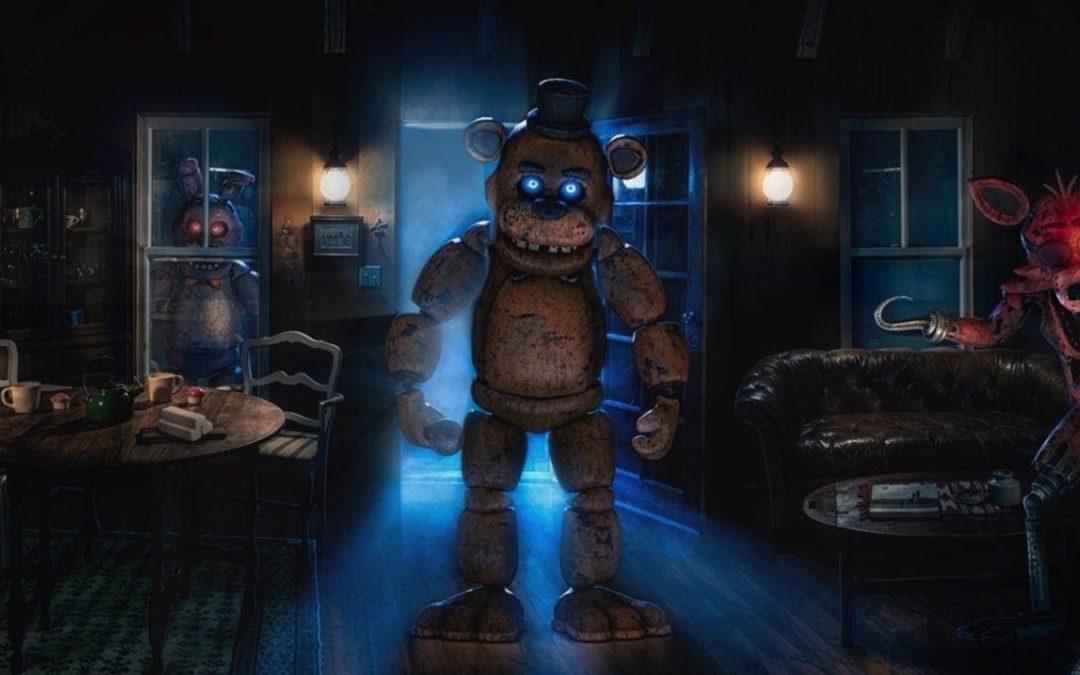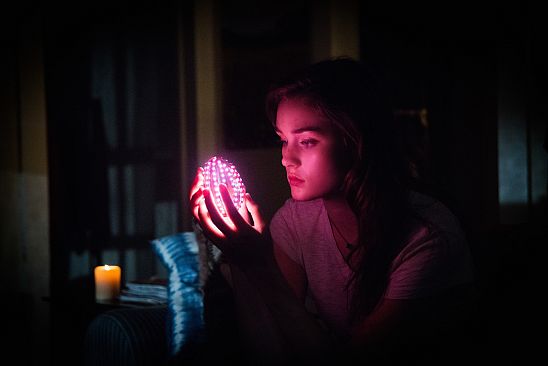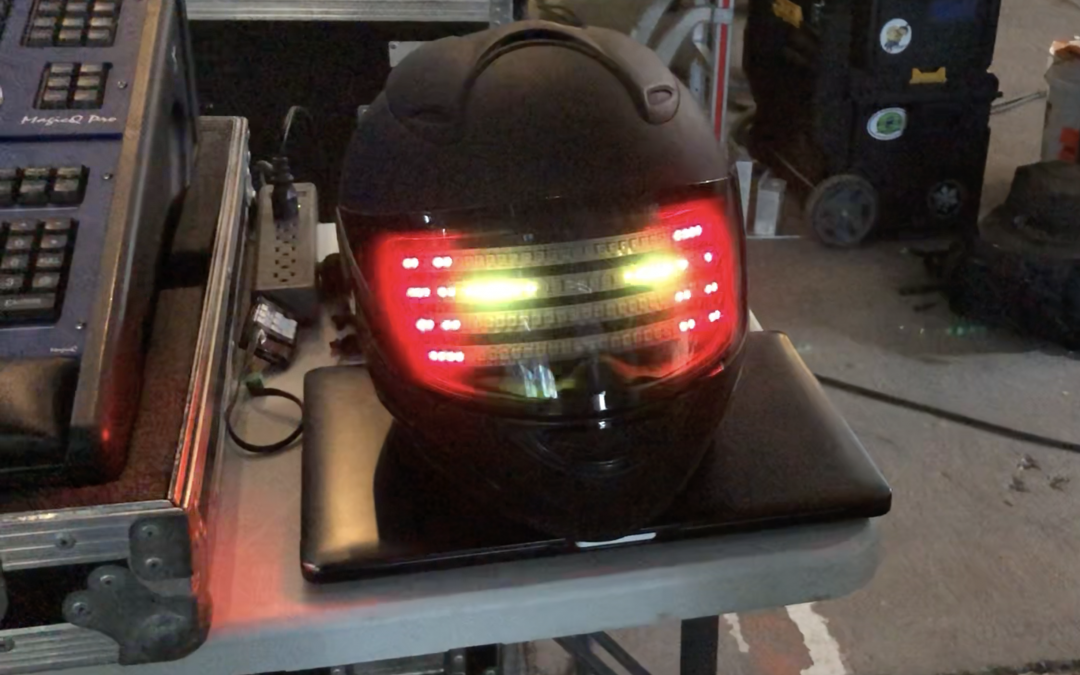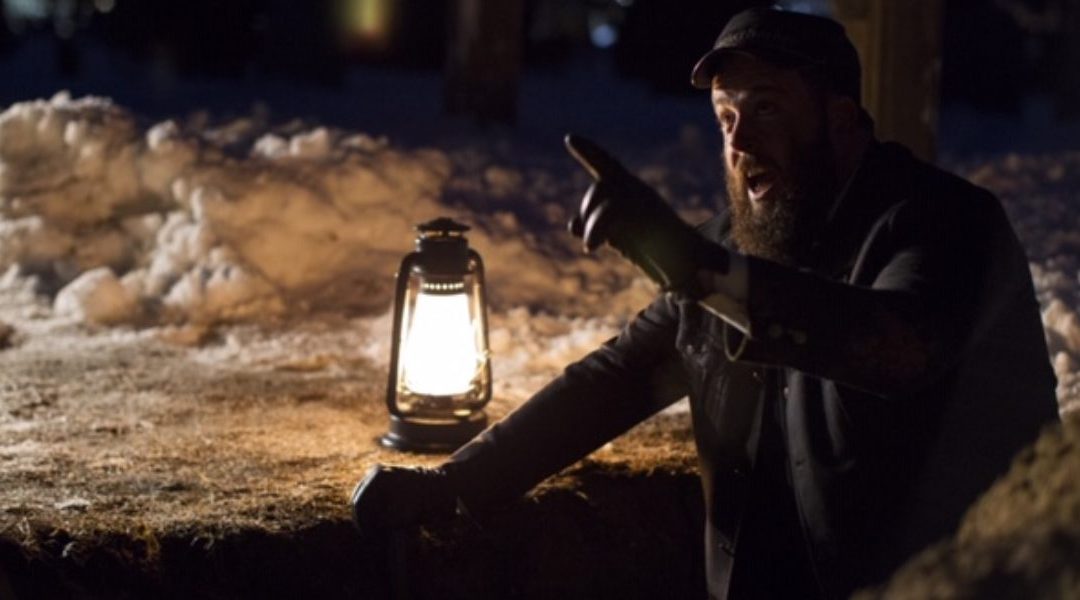
by Aimee Wilson | Oct 16, 2023
Evil Animatronics Required? #RC4DoesThat
Alright … so we can’t take alllllllll the credit*.
When Joshua Anderson, self proclaimed chief fixtures nerd, contacted RC4 Wireless, he knew he needed something that would punch through all the movie set hazards in filming.
RC4Magic 900MHz gear was incorporated to help bring to life these magnificent creatures and boy, did they deliver by the looks of it!
Writing this before it’s release in theaters and streaming on Peacock October 27th …. RC4 Wireless is not responsible for any night terrors you or your loved ones might have.
Enjoy!
Check out the Official Trailer here.

by Aimee Wilson | Sep 6, 2022
“I’ve built my reputation on being the wireless guy since I don’t run any dmx from my cart to my dimmer console, so I’ve made a niche for myself,” states Wilmington, NC-based lighting console programmer Tommy Sullivan Jr. Sullivan’s credits include the SpongeBob Squarepants movie, Swamp Thing; Homeland; and Steven King’s Under the Dome, just to name a few. Some of his success is due to his equipment. “Every single DMX controlled light that we carry on our cart has a RC4 Wireless 900MHz miniature data receiver that we keep on it,” he confides.
Sullivan is also an RC4 Wireless power user. “I have quite the collection of RC4 products; Jim has told me I’m up there with Disney when it comes to the amount of RC4 gear I own,” Sullivan admits. In fact, his collection includes the original RC4 line, RC4Magic, the 900 series and LumenDim devices. Sullivan notes, “I love the RC4 stuff, it’s never let me down”.
Sullivan began working with RC4 equipment in 2014 while he was on the CBS TV drama Under the Dome. Sullivan explains, “I was approached about making an egg that would light up. We explored different options that actors would carry around, and then on cue, it would glow and change colors.” His initial ideas involved wired solutions. “Originally, we were looking at making something that had wires and would be tethered; it would hide a battery pack on the actor. I started doing research online, and stumbled across RC4, and realized that they were also in North Carolina. I thought, ‘this is perfect,’ he says. Sullivan then pulled the metaphorical trigger that would transform his work life. “I gave Jim a call, and got 2.4GHz 2-channel wireless dimmers. I took it, mounted the battery pack inside the egg and it worked perfectly.”
From there, Sullivan moved from the RC4Magic 2.4GHz band to the RC4Magic-900MHz line of products. Sullivan explains, “The 900MHz series of products work better for me because it’s a less congested bandwidth, there are fewer people on it and the range is much better than 2.4. It penetrates stuff better; up here, we have to contend with humidity and rain and all sorts of things that 2.4 doesn’t do well with. The 900 dimmer checks off all the boxes for us and it’s been very reliable.”
One of the challenges that people in all sectors of entertainment have to deal with are buildings and cement; Sullivan has also faced that circumstance. “When I was working on Under the Dome, we shot a lot in an old cement factory that was made completely out of cement. There have been lots of big movies—like Teenage Mutant Ninja Turtles—that shot there going back to the 80s,” Sullivan notes. That’s where he used the RC4Magic-900MHz dimmers. “They worked perfectly,” he reports.
The performance of RC4 gear—especially the 900MHz line—has astonished some of Sullivan’s co-workers. He notes: “I’ve had people come in from out of town on our crew, take a light out in the distance, and say ‘there’s no way you’re going to get signal out to this.’ I push a button; it immediately comes on and they say ‘oh my God.’ “That leads to another happy circumstance. “The next week they’re calling Jim and Aimee to order theirs. Every time I show someone that does what I do, they are instantly turned onto it and end up making a purchase themselves,” Sullivan says with a smile.
The film community in the Wilmington area is a tight-knit one, and Sullivan works hand in hand with his fellow electricians. He has found that the RC4 LumenDim products, which work with Lumen Radio CMRX transmitters, are the perfect solution for many of his props. He explains, “For props, I’ve found it helpful to use the push to pair feature of the LumenDIm dimmers. If a buddy of mine on another show needs to borrow a lantern, I can just give it to him. All he has to do is push it and pair it to his transmitter. We have three shows that are in production in town, and we’re a tight-knit film community, so we share things. Having a push to pair has made that easier.”
RC4 Wireless dimmers aren’t only used for lighting; they’re also great for props. Sullivan has used them for countless lanterns and flashlights, as well as for products that are unique crossovers. He picks up the story: “On Under the Dome, we had a flashlight that the bulb was supposed to explode; then it was supposed to drop on the floor and start vibrating. It was supposed to be possessed.” Creating a possessed flashlight is, as one would imagine, a challenge. “Back then, I was still using the 2.4 system, and I did have some challenges with that, since they wanted it in a Maglite, which was all metal. I had to drill a hole into it to bring the antenna out, and I had to custom-make the battery pack go inside of it. With normal operation, the guys walk around with a flashlight and I was running it at 50%. When it was supposed to blow up, I cranked it up, and the bulb actually blew up,” Sullivan reports.
The story then takes an unexpected turn once the flashlight hits the ground. “Here’s the funny part– I took apart a small personal massager and mounted the motor inside so when the guy dropped it on the concrete, it would start vibrating on the ground. After that, via effects, they made it even more crazy. For what we needed to accomplish on set with the actors, it was perfect,” he reports.
The unexpected surprises continued with the flashlight. Sullivan continues: “Our accountants on the show eventually ended up with the receipt for the vibrator, our Best Boy who does all of the purchasing, got called into the office for it.” It wasn’t the first time that management questioned an unconventional purchase. “The glowing egg that we created, we had to put it underwater, and it comes floating up to the surface. We found the best way to protect it underwater was to use a condom. So, we put the egg in a condom, tightened it up, and sunk it to the bottom. The accountant called him into office for that as well. He explained it and it all worked out, but they had quite a few laughs,” confides Sullivan.
Early on, Sullivan had to call RC4 customer support. “They have hands down the best customer service and technical support of anyone in the market,” Sullivan says. Some of those calls end up going to James D. Smith, RC4’s president and chief product developer. Sullivan adds, “There are not many companies you can call and talk to the developer directly. We’ve spitballed ideas for product improvement, and different ways of doing things and it’s been helpful to have that.”
In the end, Sullivan notes, “I’ve encountered some gaffers—they’re the head of the lighting department—that’s who I work under who say ‘I don’t like wireless, it doesn’t work’.” He has a simple response: “I say you’ve been using the wrong stuff. I’ve had RC4 Wireless equipment work outside for over half a mile away, and still be instantaneous and still do effects that require fast data transmission. It just works flawlessly.”

by Aimee Wilson | Jul 12, 2022
“I became aware of RC4 wireless back in 2015,” states Sean McClellan, a feature film and television gaffer and best boy electric based in Albuquerque. “I was working as a core electrician back on a show called Independence Day: Resurgence, and there were many alien blaster prop guns that had integrated [RC4 Wireless] DMX4dims. That’s where I began to learn about them. Our lighting equipment package outside of the props world encompassed LEDs and included custom-built miniature LED pads and sticks; they were just ribbon-based LED products of various sizes that we would control with RC4 DMX4dims. The RC4 equipment was there, I saw it and thought ‘what is this really cool piece of technology.’ That’s where I got my start learning about the RC4 ecosystem,” he notes.
From there, McClellan began to delve into the world of RC4 Wireless products. “I started to learn about it and when there was a lull between lighting setups, I would sit there on my phone and I would scroll through the user manuals from the website,” McClellan notes. “I would familiarize myself with the product line, how to configure them, how to troubleshoot, and learned what all the blinking lights meant. I really educated myself on the system.” His first RC4 Wireless purchase was the ever-popular DMX4dim. “After I learned that system, I went on to gaff a couple of smaller projects, and I purchased my first set of DMX4dims with the transmitter, the DMXio, and from there, I built my own custom LED pads and sticks. From there on out, my inventory expanded, and I started dipping into LumenDim devices. From there, I primarily stayed in LumenDim.” McClellan has a variety of RC4 Wireless LumenDim devices, including the LumenDimPix and LumenDim micros. “In our workflow, with my gaffer, Jay Kemp, we keep the DMX4dims as a backup system,” adds McClellan.
One of McClellan’s favorite features of the LumenDim products appeared in July of ‘21. McClellan explains: “The latest firmware that just came out-the motion picture profiles, that’s my go-to now because it mimics popular CCT/RGBW modes found in professional lighting products, such as Arri, KinoFlo, and so on. To me, that’s pretty unique. My gaffer and I have newly designed LED pad and stick fixtures that were built to maximize these new profiles, so being able to use that with our programmer and have a seamless profile that works across the board that you can color match more easily, that’s probably my number one go-to feature.” James David Smith, CEO and Chief Product Designer at RC4 Wireless notes, “Last year, I created two new color-control profiles that I based on existing fixtures made by Arri, Kino Flo, and Astera. Since everyone in motion picture work uses those fixtures all the time, it made it much easier for them to use our devices.”
Since McClellan is in New Mexico, he works on plenty of period westerns. “We typically use a lot of the LumenDimM2micro and M4micro units for lantern effects. We’re always modifying handheld lanterns to work wirelessly on batteries. People think it’s just a lantern, but so much goes into it to make it reliable. Not only for the battery, but also being reliable if it gets dropped.” In the winter of ’21-‘22, McClellan was on the film The Pale Blue Eye that used 12 lanterns with RC4 Wireless LumenDimM4micros with external antennas for added signal strength. “Each character had a different style lantern and we had to be prepared with backups in case someone slipped and fell down.” We had three backups for each style of lantern all set, teched-out with the programmer, Kevin Hogan, in case the lantern got dropped and didn’t work,” recalls McClellan. The lanterns—as well as the RC4 equipment—worked perfectly.
RC4 Wireless gear is also there when it’s time to do pixel effects. “Back in 2019, we did a Netflix tv show called Daybreak, and the director wanted to mimic a Daft Punk-style motorcycle helmet. I worked with the rigging gaffer, Theo Bott, and the fixtures foreman, Joshua Phillips, and we used the LumenDimPix pixel drivers. We made a Daft Punk-style helmet for that which looked really cool on camera. Our programmer, Patrick Toohey, did some really cool pixel mapped effects on it,” McClellan states.
Recently, McClellan worked on a film that IMDB calls Wile E. Coyote. He explains, “We primarily used LumenDim4s, LumenDimM4s and M6s to control our LED light pads and litemats. I also worked with the fixtures foreman, Todd Roberts, on that job; they had to build a proxy bomb and wanted to simulate the fuse igniting. We took a couple of LumenDimM4 micros, and stuffed them down in there with some 5 channel LED ribbon to emulate the flicker from a fuse. That’s one of the things I love about the RC4 equipment is the versatility; you can take a device, you can change modes and do a Flickr effect, you can use straight DMX control or you can use RC4 Colormatch™. The versatility in each device is pretty astounding actually; it enables end-users to tailor the device to their work flow and get the desired end results rather quickly.”
For people who haven’t used RC4 equipment, McClellan says, “If someone is working in special effects and they need to control a servo motor or a telephone, they should look at RC4, because chances are they’re going to have some sort of feature that will suit your needs.”

by boss | Jun 3, 2019
Motion picture and tv gaffer Peter Walts of Labour Party Lighting is a busy man. He’s worked on numerous feature films and tv series, including Magic Mike, Contagion, Side Effects and more; his tool kit includes dimmers from RC4 Wireless. “In terms of finances, RC4 Wireless products work equally well in both the large budget and modest budget realms,” states Walts. In 2014, Walts worked on the critically acclaimed Steven Soderbergh cable series The Knick. “It was a full budget feature with a full-time board op; we used [RC4 Magic] DMX4Dims and we used the Flkr Effects Engine; it’s the best flicker engine on the market,” Walts says. The Flkr Effects Engine is an integral part of the RC4 Harmonized Design platform and is a part of all RC4 Magic wireless dimmers. “Our RC4 Flkr Engine is my first US Patent, so it’s kind of special to me. I worked with top designers at Disney to create a general framework they really liked and then consulted with numerous other RC4 Wireless users to fine-tune it. The result is a parametric method of defining a huge range of effects. Each parameter is controlled by a DMX channel level, much the way channels control parameters in a complex moving light,” notes James D. Smith, Chief Product Developer at RC4 Wireless. The Knick—and Soderbergh—also threw some curve balls at Walts. “The way Steven works, he shoots from the hip, so we didn’t pre-plan a lot of things. Steven would be editing at night, and then change his mind about the staging of a scene the next day. He’d suddenly want the actors to walk down a dark hallway; I always asked ‘are they holding a lantern?’ He’d want lanterns, so we’d turn them on and dial them on using the console or use it directly via the luminaire. With the Flkr Effects Engine, we had the ability to change a number of parameters and give our lights nuance; as a battery powered wireless dimmer, it’s perfect,” Walts says. Walts also found himself in a graveyard with a single lantern during the run of The Knick. “He explains: “We built a four channel LED into the lantern and we created a beautiful effect with the RC4 unit; we could even change the nuances in the course of the dialogue if we wanted to. The actor then put the lantern down, and then there was a four-page scene, and the lantern was the only light.” Fast forward to 2018 and Lizzie, a re-telling of the Lizzie Bordon tale directed by Craig Macneil. “I couldn’t hire a programmer for Lizzie, and used the DMX4dim directly with a luminaire, but I could still do it all myself. In fact, when we were working on Lizzy, there was no DMX except the RC4 equipment,” Walts explains. Once again, Walts turned to RC4 Wireless dimmers and the Flkr Effects Engine; this time it was for a fire. Walts explains: “For the scene, we would be hand-held so I couldn’t have any cables; we took Litegear LiteRibbon x2, x4, and x6s, laid them on a 2×3 flag along with a battery and put it in a fireplace along with the RC4 dimmers to create the fire. I had my battery-powered LED flag with four channels of different glows, we could make it brighter, or turn it down and make it smoother. It was also the only light in the scene.” Smith adds: “The most powerful elements of the Flkr Effects Engine are the random-number-generators. You can set up a look you like, and then apply varying amount of randomness to select parameters. Since every unit is creating its own randomness, you can configure many devices with exactly the same set of parameter values and they will all look like the same effect but not synchronized. Design a fire in a barrel effect, then put it in multiple barrels all over the stage and they look totally realistic because of they all dance the way you want, but they all dance independently — just like real fires in barrels would. The RC4 Flkr engine is one of the most powerful effects systems out there, but it’s still easy to use and understand with a wide gamut of looks it can produce.” As Walts looks towards the future, he sees… productions that are wireless. “More and more, we’re being asked to do high budget effects with lower budget means, and RC4 Wireless products are terrific for me. I could go full bore with the RC4 Wireless equipment and use it with a programmer, or use it alone, depending on the budget and the scope of the show,” he concludes.

by boss | Sep 5, 2017
Tony Kushner’s epic two-part drama Angels in America was first seen at Britain’s National Theatre back in 1992. Now to celebrate its twenty-fifth anniversary, the plays have returned to the National, in a new production directed by Marianne Elliott and with lighting by Paule Constable (a duo whose previous collaborations have included War Horse and The Curious Incident of the Dog in the Night-Time), alongside scenic design by Ian MacNeil and costume design by Nicky Gillibrand, whose work together has included Billy Elliot.
From the earliest model showings Laurie Clayton, the lighting supervisor for the National’s Lyttelton Theatre where the show was to be performed, knew that it would present a number of challenges. In particular, there was a desire to include lighting in elements of scenery carried on the show’s three revolves plus separate rim revolve yet there was no depth in those revolves to incorporate slip rings to power that lighting. And there were many practicals that would either travel on stage as part of moving scenery or be carried on stage by the cast and set on the revolves or other areas of the set, which spread across every inch of the Lyttelton’s stage and beyond.
But Clayton already knew the solution to these challenges: RC4 wireless dimming. And not only did he know the solution, but he had quite a stock of RC4 products already available in-house to implement that solution.
“I think the first time we used RC4 products was on One Man, Two Guvnors back in 2011, when we bought one transmitter and six two-way dimmer modules. We used the same set-up on the tour, and they worked flawlessly,” he explains. “Since then we’ve added to our stock as we’ve needed to for productions such as Curious Incident and Great Britain, so we have a pretty good stock of RC4’s products in-house now. But the demands for Angels in America were so great that even with that stock, we had to do some shopping, adding a further ten dimmer modules of various types.” The additional units were quickly delivered by RC4’s UK distributor, Lamp & Pencil.
Angels in America’s RC4 kit list features 10 RC4Magic DMX4dim four-way dimmer modules, two RC4Magic DMX4dim-500 high-capacity dimmer modules, and 20 RC4Magic DMX2dim two-way dimmer modules. Some are mounted to scenery, some hidden in stand-alone furniture, and some concealed in individual practical light fittings: as well as a good stock of RC4 dimmer modules, the National also has a healthy stock of batteries and battery chargers to power everything. During the tech period, the National’s lighting team found good LED substitutes for the tungsten lamps originally fitted in some of these practicals, which presented no problems to the RC4 dimmers and dramatically extended the working life of the batteries. “Plus the RC4s great control of LEDs meant we had no problems at all when the TV cameras came in for the NT Live world-wide broadcast of the shows,” Laurie Clayton notes. He also comments particularly on the compact dimensions of the RC4 units, which lets them be hidden away in even the smallest of props or tightest of spaces: “no-one else makes anything as small.”
All of the receivers are fed by one RC4Magic DMXio transmitter, mounted behind the proscenium on one side of the stage. “The signal from that gets everywhere; we have had no problems at all with coverage, which is pretty impressive given that we’re using the full width and depth not just of the stage but of the scene docks behind and next to the stage!” However, the RC4 system’s unique ID ensures that there is no chance of interference with RC4 systems in use in the National’s other two auditoria.
While most of the RC4 units are used very traditionally, as wireless dimmers, one is used for a more complex effect: a telephone switchboard has a Raspberry Pi computer hidden inside to detect which buttons on it are pushed by the actor. This information is transmitted via WiFi to the sound control computer to trigger the relevant sound effect; the sound desk then triggers the ETC Gio lighting console via the OSC protocol, which then turns on the appropriate light in the switchboard via RC4 dimmers.
Though Angels in America is now approaching the end of its National Theatre run, the National’s RC4 stock will be kept busy with uses already lined up on the company’s next two productions. “They’re a great product,” Laurie Clayton notes, “tiny, versatile, reliable, do just what they promise, and with great support from the manufacturer and their distributor here on the odd occasion when something does go wrong or, more likely, when you need to make the dimmers do something no-one’s ever made them do before.”
Written by Rob Halliday.




